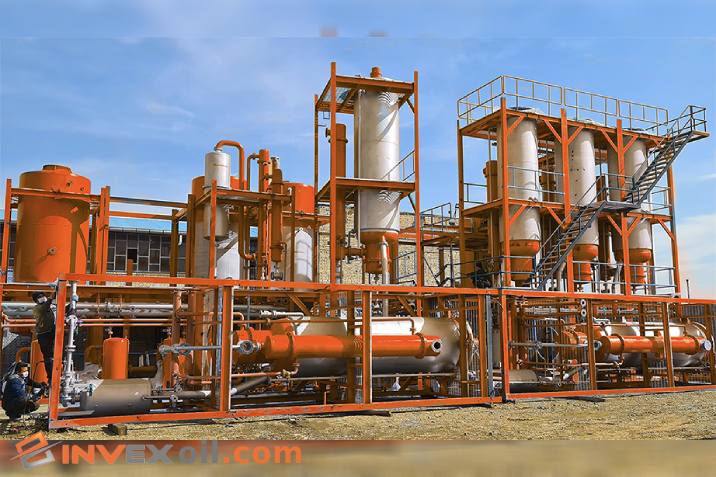Dielectric strength is a vital metric in the electrical industry, and it is used in the oil industry especially when we discuss Transformer oil treatment. It serves as the linchpin determining how much electrical stress voltage, a substance can withstand without breaking down. The dielectric strength of a transformer oil signifies its maximum capacity to resist electrical breakdown. It’s a critical value, ensuring the smooth and safe operation of transformers. In essence, the higher this strength, the better the oil prevents unwanted electrical discharges within the transformer.
Table of Contents
Factors That Affect the Dielectric Strength of Transformer Oil
The dielectric strength of transformer oil is not just a constant value. It’s influenced by several factors, making it imperative for those in the oil, gas, and chemistry industries to have a comprehensive grip on these determinants. aging of transformer oil can cause the loss of its dielectric strength leading to costly equipment damage and potential safety risks. In this article, we will check many aspects of dielectric strength.
In this table we are going to check Effects of Different Factors on Dielectric Strength to understand them, better.
| Factor | Low Impact | Moderate Impact | High Impact |
| Temperature | 25°C | 50°C | 75°C |
| Moisture Content (ppm) | 10 ppm | 50 ppm | 100 ppm |
| Presence of Impurities | 0.01% | 0.05% | 0.1% |
-
Temperature Fluctuations
The temperature of transformer oil impacts directly its dielectric strength. According to the first table of this content, as the temperature rises, the dielectric strength tends to decrease. That’s why it’s essential to monitor and maintain the optimal operating temperature range. Looks at the previous table again, related to this table, in fact, for every 10°C increasing in temperature, there’s a noticeable drop in the dielectric strength.
-
Moisture Content
Water content, even in minuscule amounts, can be detrimental to the dielectric strength of a transformer oil. Moisture can come from outside, like leaks or high humidity, or from inside, when cellulose insulators break down. That’s why it’s important to keep an eye on and manage the moisture level. Too much moisture can quickly make the dielectric strength drop. To help you understand this better, we’ve made a table.
This table shows Impact of Moisture Content on Dielectric Strength and how can they effect. In this table, you can easily find that Moisture content and Dielectric strength have Inversely relation. When Moisture content increase by 50 ppm, dielectric strength will decrease 20 kV!
| Moisture Content (ppm) | Dielectric Strength (kV) |
| 10 ppm | 65 kV |
| 50 ppm | 50 kV |
| 100 ppm | 30 kV |
-
Presence of Impurities
Impurities, whether they are from the environment or they come from, even contaminants introduced during transformer oil maintenance, or became as byproducts from the oil’s degradation, regularly can affect dielectric strength. Particles, for instance, create potential paths for electrical discharge.
Furthermore, the metallic particles can be more harmful than others, cause they lead to localized regions of high electric fields, which reduces the overall dielectric strength and may disable it. Finally, it’s important for any kind of industry to Monitor them regularly and filtration processes are recommended to keep impurities out of your devices.
Testing Methods for the dielectric strength of a transformer oil
Before learning the specifics of how the dielectric strength of transformer oil is tested, it’s useful or even essential to understand why it’s significant for us. In this part of electrical equipment, particularly transformers, the dielectric strength of oil is lead in ensuring optimal performance and safety. In fact, this metric measures how well the oil resists electrical breakdown and this is an important characteristic in a medium that’s meant to insulate and protect.
But how do professionals determine the dielectric strength of transformer oil? By using specific testing methods and commitment to standards, especially those provided by the ASTM. To understanding them, we provide a useful table for you, here you can find this table:
In this special Table, we are going to check some standards created by Breakdown Voltage Test Results by ASTM Standard. Check them and remember them.
| ASTM Standard | Minimum Breakdown Voltage (kV) | Typical Test Duration |
| ASTM D877 | 27 kV | 60 seconds |
| ASTM D1816 | 30 kV | 60 seconds |
| ASTM D3300 | 35 kV | 60 seconds |
1-Breakdown Voltage Test
When discussing the dielectric strength of transformer oil, the Breakdown Voltage Test often emerges as a frontrunner. It’s not just about numbers; this test serves as a reflection of the oil’s quality and its capability to resist electrical stress. Please check the table again and follow the article. The methodology is straightforward:
- Two electrodes are immersed in the transformer oil.
- A gradually increasing voltage is applied.
- Observers note the voltage at which a breakdown occurs, signifying the oil’s dielectric strength.
2-ASTM Standards and Procedures
As any professional manager or engineer knows, Standards matter. The American Society for Testing and Materials that called ASTM, has been at the forefront of setting these standards, particularly when it’s about to transformer oil testing. Obligation to ASTM standards isn’t just about ticking a box or checking in schedule; it’s about making sure the oil’s quality, longevity, and most important factor, safety is okay and there isn’t any other problem.
For instance, the ASTM D877 method involves testing at room temperature with flat disk electrodes, while the ASTM D1816 uses spherical electrodes and a specific gap. On the other hand, the ASTM D3300 method adjusts the test gap and employs cylindrical electrodes.
Low Dielectric Strength: Risks and Implications
As we understand, in the transformer industry, the dielectric strength of transformer oil isn’t just another number. It so important for us to ensure safety and efficient operation. Think of it as the obstacle between smooth operation and potential hazards. When this obstacle is weakened, due to oils with subpar dielectric strength, the risks amplify.
In this table, we are going to cover Safety Incidents Related to Low Dielectric Strength in USA.
| Year | Incident Description | Location | Equipment Affected |
| 2018 | Oil breakdown leading to minor explosion | Texas | Power Transformer |
| 2019 | Insulation failure and fire outbreak | Ohio | Distribution Unit |
| 2020 | Arcing and subsequent power outage | Florida | Circuit Breaker |
In addition to these incidents, several unrecorded cases occur every year, that they force us to focused on stringent quality control.
-
Safety Concerns
Safety isn’t just a word; it’s a commitment, especially in industries relying on heavy electrical equipment. dielectric strength of a transformer oil, can become the main suspect of many accidents. For instance, oils that don’t meet required strengths can result in electrical discharges. Such discharges not only endanger the equipment but can also pose direct risks to the personnel working around them. Therefore, ensuring oils of the right dielectric strength becomes a non-negotiable aspect of operational safety.
-
Potential for Equipment Damage
We’ve learnt about safety concerns, but there’s another problem: the possibility of damaging equipment.
We’re talking about things like transformers, circuit breakers, and distribution units, not just technical terms, but valuable investments. If the oil in transformers isn’t good at preventing electrical problems, it can lead to sparks, breakdowns, and even equipment failure.
Conclusion
In the end, the dielectric strength of a transformer oil isn’t just a fancy term. It’s the key to keeping transformers safe and working properly. When you’re picking oil for transformers, it’s important to make sure it’s good at preventing electrical issues. Understanding this can help to ensure a constant supply of electricity and longer-lasting equipment.
FAQ
What exactly is the dielectric strength of a transformer oil?
Dielectric strength measures the maximum electric field that transformer oil can withstand without breakdown, ensuring it effectively insulates and prevents discharges.
Why is the dielectric strength so vital?
It ensures safe transformer operation by preventing unwanted electrical discharges. High dielectric strength means better insulation and reduced failure risks.
How is the dielectric strength of transformer oil tested?
It’s tested using a procedure that exposes the oil to increasing voltage levels until a breakdown happens, revealing the oil’s insulation threshold.

Hello, This is Matteo Hudson Copywriter from InvexOil. We are here to provide super-important content to help you learn more easily and be involved in the world of Petroleum and Chemistry. We are here to answer your questions, help you to have better services, and also find the best solution for your problems. Don’t be shy and ask your questions in the comment box or call our number. If you want to connect with me directly, you can search for my name on Linkedin.





